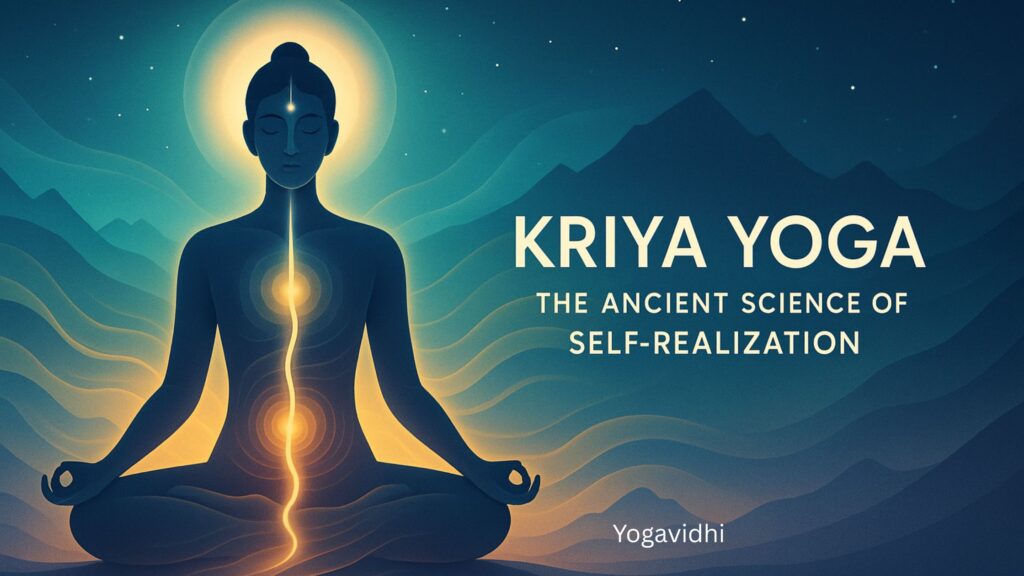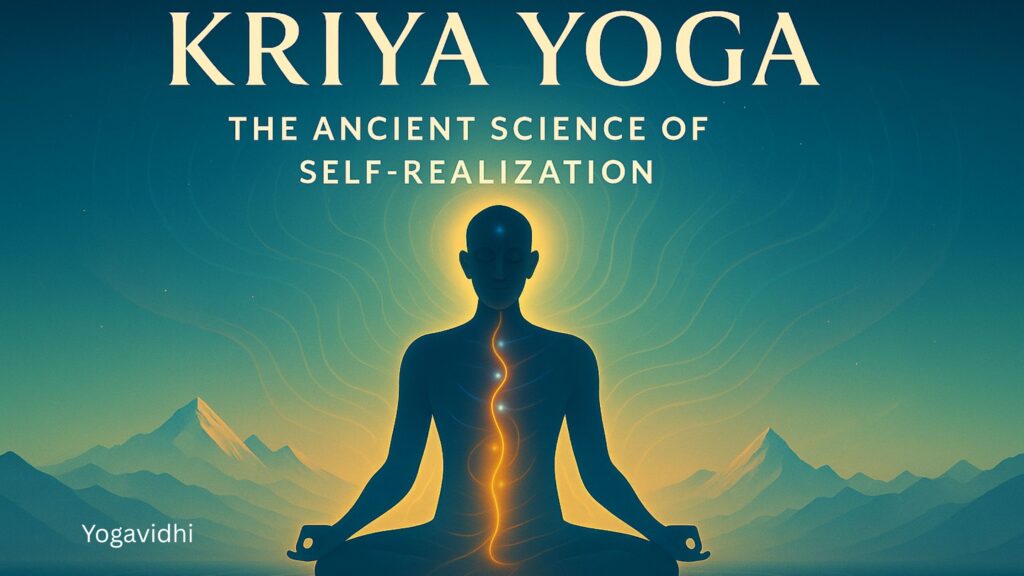In a world overwhelmed with distractions, stress, and constant motion, the need for inner peace and spiritual growth has never been more urgent. While many turn to yoga for physical flexibility or mental calmness, few are aware of a deeper yogic science that holds the key to awakening your true potential — Kriya Yoga.
Rooted in ancient Indian philosophy and brought to global attention by great masters like Paramahansa Yogananda, Kriya Yoga offers a systematic path to self-realization. In this comprehensive guide, we’ll explore what Kriya Yoga is, its origins, benefits, techniques, and how you can begin your journey toward inner transformation.
Kriya Yoga is a meditative practice designed to speed up spiritual growth and attain union with the divine. It incorporates precise techniques involving pranayama (breath control), mantra, and mudra. The goal of Kriya Yoga is to cleanse the body and mind, guiding the practitioner toward deep inner peace and communion with God. This practice was widely introduced to the world by Paramahansa Yogananda in his renowned book Autobiography of a Yogi.
Table of Contents
What is Kriya Yoga?
Kriya Yoga is a sacred spiritual technique that combines powerful breath control (pranayama), deep meditation, and inner energy awareness to accelerate spiritual evolution. Unlike popular yoga practices that focus primarily on physical postures (asanas), Kriya Yoga emphasizes subtle energy control and the awakening of consciousness.
The term “Kriya” comes from the Sanskrit root kri, meaning “action,” and “Yoga” signifies union with the Divine. Together, Kriya Yoga means “union through action”– not just external physical actions, but inner techniques that purify the body, mind, and soul.
“The Kriya Yoga which I am giving you is not a new technique. It is the ancient science of self-realization.” – Paramahansa Yogananda
The Origins and Lineage of Kriya Yoga
The origins of Kriya Yoga trace back to ancient India, preserved through a sacred lineage of enlightened masters. It was revived in modern times by Mahavatar Babaji, an immortal yogi believed to still reside in the Himalayas. Babaji transmitted the technique to Lahiri Mahasaya, who taught it to Swami Sri Yukteswar, who then became the guru of Paramahansa Yogananda.
Yogananda’s classic book “Autobiography of a Yogi” introduced millions to the wisdom of Kriya Yoga. His organization, the Self-Realization Fellowship (SRF), along with its Indian counterpart, Yogoda Satsanga Society (YSS), continues to teach the authentic form of Kriya Yoga globally.
The Spiritual Philosophy Behind Kriya Yoga
Kriya Yoga is not just a set of techniques—it’s a philosophical and spiritual path aimed at achieving union with the Divine. It recognizes the spine and brain as the principal centers of spiritual energy, and through breath control and meditation, practitioners awaken the dormant energy known as Kundalini.
By practicing Kriya Yoga, one gradually burns karma (the effects of past actions) and rises above the dualities of life—pleasure and pain, success and failure. It leads to moksha, or ultimate liberation.
Core Techniques of Kriya Yoga
Kriya Yoga techniques are designed to direct prana (life force) consciously through the spine. Though the full set of practices is typically given after formal initiation, here are some foundational elements:
1. Kriya Pranayama
This is the heart of Kriya Yoga. It involves mentally directing life force up and down the spine with each breath. This clears the energy channels (nadis), balances chakras, and brings the practitioner into higher states of awareness.
2. Meditation Practices
Kriya Yoga incorporates deep concentration and meditation to still the mind. Techniques like Hong-Sau and Om meditation help control thoughts and develop inner stillness.
3. Energy Control (Pratyahara)
Practitioners learn to withdraw the senses from external distractions and internalize their awareness, entering a profound meditative state.
Benefits of Practicing Kriya Yoga
Kriya Yoga offers transformational benefits on all levels- physical, mental, emotional, and spiritual.
Physical Benefits
- Regulates the nervous system
- Enhances lung capacity and breath control
- Boosts vitality and immunity
Mental Benefits
- Improves concentration and focus
- Reduces stress, anxiety, and depression
- Promotes emotional stability
Spiritual Benefits
- Awakens higher consciousness
- Cleanses karma and purifies the subtle body
- Accelerates the path to enlightenment
Many practitioners report experiencing deep peace, blissful awareness, and a profound sense of connection with the universe through consistent practice.
| Category | Details |
| Yoga Type | Kriya Yoga (Spiritual & Meditative Path) |
| Origin | Ancient India; revived by Mahavatar Babaji |
| Popularized By | Paramahansa Yogananda (via Autobiography of a Yogi) |
| Core Practice | Breath control (Pranayama), meditation, and inner energy awareness |
| Main Focus | Spiritual awakening, karma cleansing, union with the Divine |
| Physical Techniques | Minimal; primarily seated meditation and breath control |
| Mental Benefits | Enhanced focus, reduced anxiety, mental clarity |
| Spiritual Benefits | Awakens Kundalini, accelerates self-realization, burns past karma |
| Initiation Required? | Yes, for advanced Kriya techniques (via SRF/YSS or authorized teachers) |
| Beginner Friendly? | Yes, with guided preparation and foundational techniques |
| Compared With Hatha Yoga | Hatha emphasizes physical postures; Kriya emphasizes inner energy and meditation |
| Compared With Bhakti Yoga | Bhakti focuses on devotion; Kriya is a scientific method for spiritual transformation |
| Learning Resources | SRF/YSS lessons, “Autobiography of a Yogi”, online course |
| Daily Practice Time | 15–60 minutes recommended |
| Who Can Practice | Open to all seekers, regardless of religion or background |
Kriya Yoga vs Other Forms of Yoga
Unlike Hatha Yoga, which emphasizes physical postures, or Bhakti Yoga, which focuses on devotion, Kriya Yoga is centered on the scientific control of breath and energy.
It shares some elements with Raja Yoga, especially in its meditative approach, but Kriya Yoga provides more specific and direct techniques for rapid spiritual progress. It’s often referred to as a shortcut to spiritual evolution.
Read More: Yoga for Men: Build Strength, Flexibility & Mental Clarity
Read More: Yoga Day: Uniting the World Through Wellness, One Breath at a Time
How to Learn Kriya Yoga Safely
Due to the sacred and powerful nature of the practice, Kriya Yoga is traditionally taught through initiation by a qualified teacher or lineage. This ensures that the techniques are practiced correctly and yield the intended results.
Recommended Paths to Learn Kriya Yoga:
- Self-Realization Fellowship (SRF) – Offers home-study lessons and initiation globally.
- Yogoda Satsanga Society (YSS) – Indian branch offering books, lessons, and initiation ceremonies.
- Authentic Teachers – Lineage-based instructors with ties to the original teachings.
While there are online courses and videos labeled “Kriya Yoga,” it’s essential to verify the authenticity of the teacher and the tradition.
Common Myths and Misconceptions About Kriya Yoga
Myth 1: Kriya Yoga is a Religion
Truth: Kriya Yoga is a spiritual science open to all, regardless of faith.
Myth 2: It’s Only for Advanced Yogis
Truth: With the right guidance, even beginners can begin practicing preliminary techniques.
Myth 3: You Need to Leave Your Normal Life
Truth: Kriya Yoga is designed for householders and can be integrated into daily life.
Kriya Yoga in the Modern World
Thanks to pioneers like Yogananda, Kriya Yoga has spread worldwide and inspired millions. Today, it’s practiced by CEOs, artists, monks, and everyday individuals who seek inner clarity, balance, and spiritual awakening.
Scientific studies on meditation and breathwork further validate Kriya Yoga’s impact on stress reduction, brain function, and emotional regulation.
A Beginner’s Guide to Starting Kriya Yoga
Not ready for formal initiation yet? Here’s how you can begin preparing:
Read Foundational Books
- Autobiography of a Yogi by Paramahansa Yogananda
- The Holy Science by Swami Sri Yukteswar
Practice Basic Breath Awareness
- Start with observing your breath daily for 5–10 minutes
- Practice diaphragmatic breathing or alternate nostril breathing (Nadi Shodhana)
Join an Introductory Course
- Enroll in free online lessons from SRF or YSS
- Attend local satsangs or spiritual meetups
Cultivate Daily Stillness
- Spend time in silence and reflection each morning or evening
- Begin a gratitude or journaling habit to deepen awareness

Conclusion: Begin Your Inner Journey with Kriya Yoga
Kriya Yoga is not just a technique—it’s a gateway to self-mastery and spiritual awakening. Whether you’re seeking deeper meditation, emotional healing, or connection with the Divine, Kriya Yoga offers a tested and timeless path.
As Yogananda once said, “Kriya Yoga is the airplane route to God.”
Are you ready to take flight?
Explore more, read deeply, and when you feel called – take the first sacred step. Your soul is waiting.
FAQ:
Q. What is Kriya Yoga and how is it different from other types of yoga?
Ans: Kriya Yoga is a spiritual path that uses breath control (pranayama), deep meditation, and energy awareness to accelerate spiritual growth. Unlike Hatha or Vinyasa Yoga, which focus on physical postures, Kriya Yoga works with inner energy and consciousness to lead the practitioner toward self-realization.
Q. Is Kriya Yoga suitable for beginners?
Ans: Yes, Kriya Yoga is beginner-friendly when approached with proper guidance. While advanced techniques require formal initiation, beginners can start with foundational practices like breath awareness, meditation, and studying the teachings of Paramahansa Yogananda through SRF or YSS.
Q. Do I need to be part of a specific religion to practice Kriya Yoga?
Ans: No. Kriya Yoga is a universal spiritual science, not a religion. It can be practiced by people of any faith or background. It aims to unite the individual soul with the Divine, regardless of religious affiliation.
Q. What are the main benefits of practicing Kriya Yoga?
Ans: Kriya Yoga offers numerous benefits including stress reduction, mental clarity, emotional balance, and spiritual awakening. It also helps to purify past karma, calm the nervous system, and awaken higher states of consciousness.
Q. How can I learn Kriya Yoga authentically?
Ans: The most authentic way to learn Kriya Yoga is through trusted organizations like the Self-Realization Fellowship (SRF) or Yogoda Satsanga Society (YSS). These offer structured lessons and formal initiation. Always ensure your teacher is part of a recognized Kriya lineage for safe and effective learning.
Q. What is the Kriya Yoga technique?
Ans: Kriya Yoga is a meditation method that emphasizes controlling the life force (prana) through precise breathing and mental techniques, with the goal of rapid spiritual advancement and union with the divine, as taught by Ananda Sangha Bangalore and the Yogoda Satsanga Society of India. The practice involves directing energy along the spine to still the mind and body, ultimately leading to heightened states of consciousness.
Q. What are the 8 steps of Kriya Yoga?
Ans: The eight limbs of yoga include yama (restraints), niyama (observances), āsana (postures), prāṇāyāma (breath regulation), pratyāhāra (sense withdrawal), dhāraṇā (focused concentration), dhyāna (meditation), and samādhi (spiritual absorption).
Q. Is Kriya Yoga difficult?
Ans: Kriya Yoga is an incredibly powerful method for pursuing the spiritual path, but it is also extremely demanding. It requires immense dedication from the practitioner. For a modern, educated individual, the level of discipline and precision that Kriya Yoga demands can feel almost inhuman.
Q. What are the 4 stages of Kriya Yoga?
Ans: Path of Kriya Yoga Course:
Level 1: Lessons in Meditation and Energization – Establishing a strong foundation in daily meditation, selfless service, and devotion.
Level 2: Exploring the Art and Science of Raja Yoga.
Level 3: Deepening the journey through Guru-Disciple relationship.
Level 4: Preparing oneself for the sacred practice of Kriya Yoga.
Declaration Note:
We use third-party videos and images on https://yogavidhi.com/ for educational and illustrative purposes. All rights belong to their respective owners. No copyright infringement is intended.



